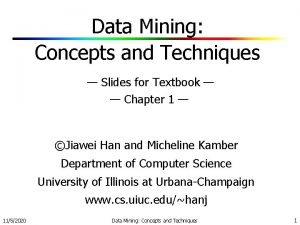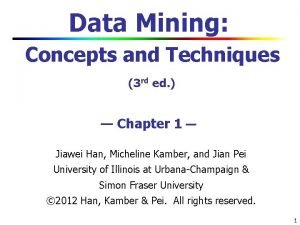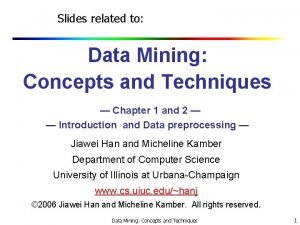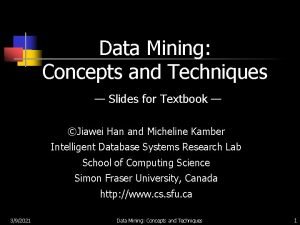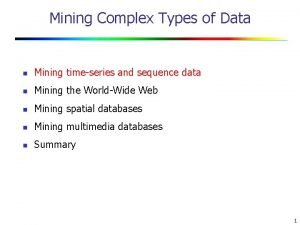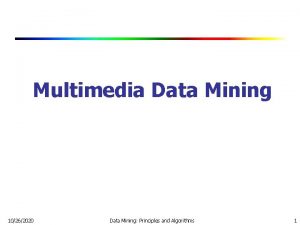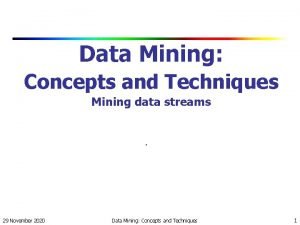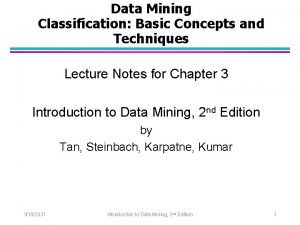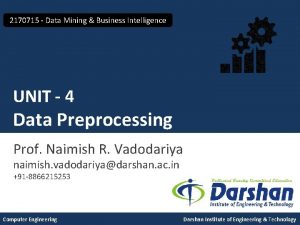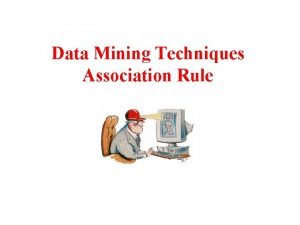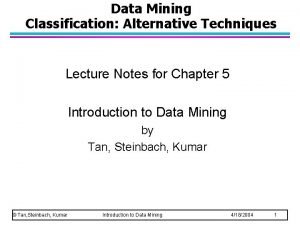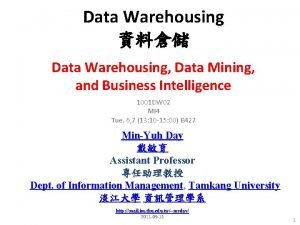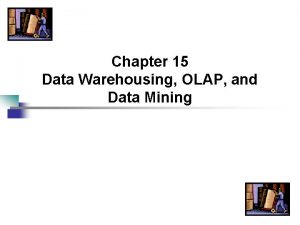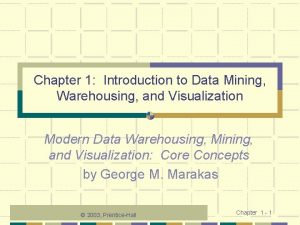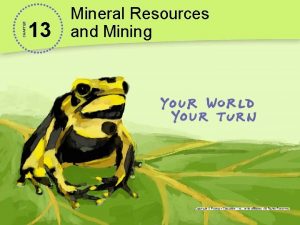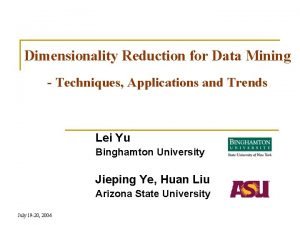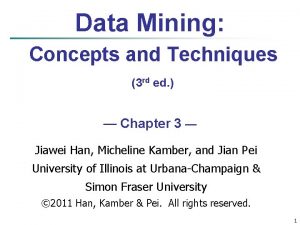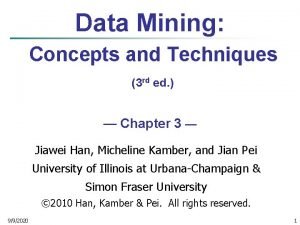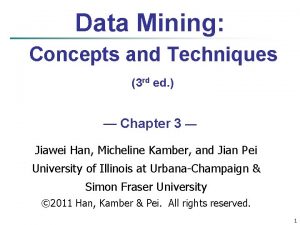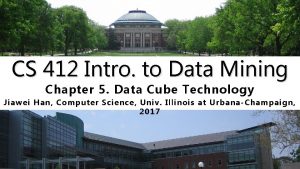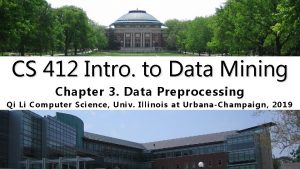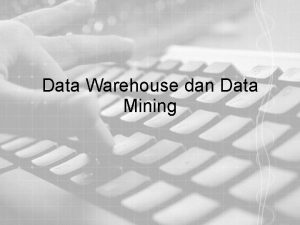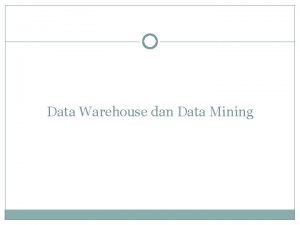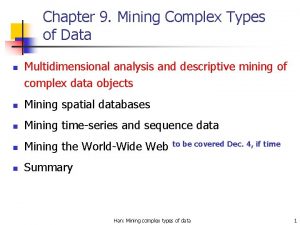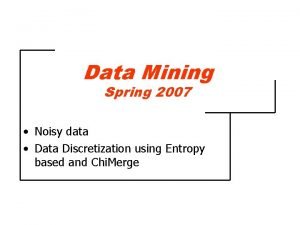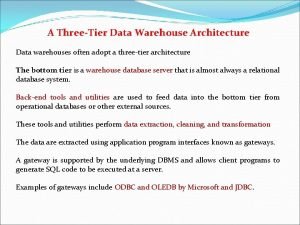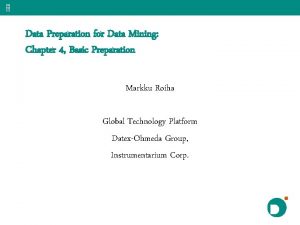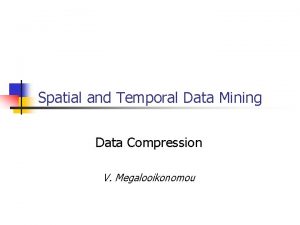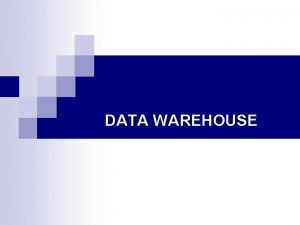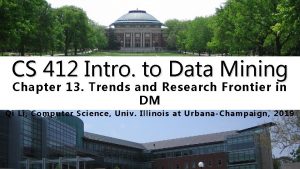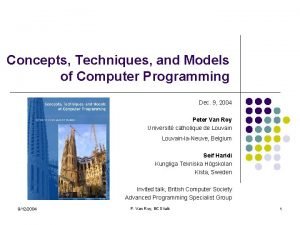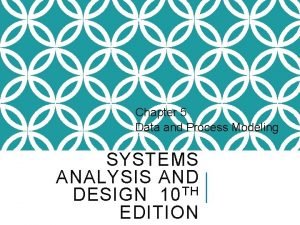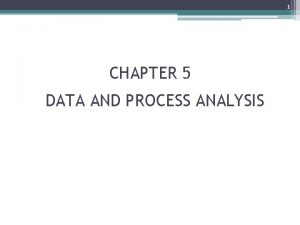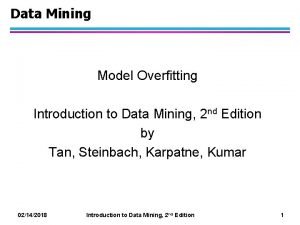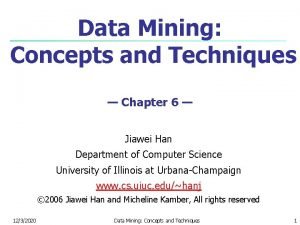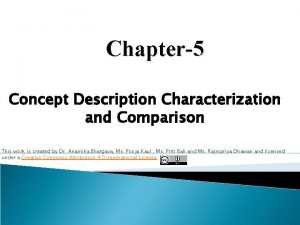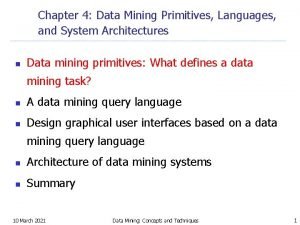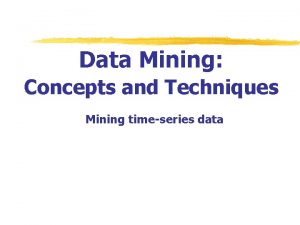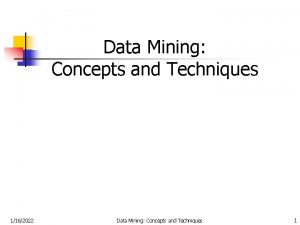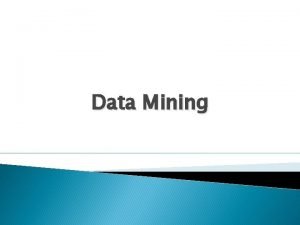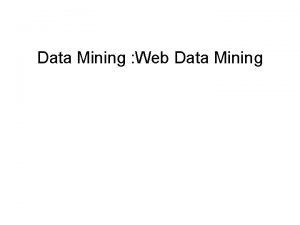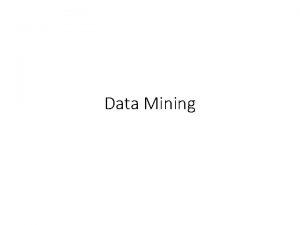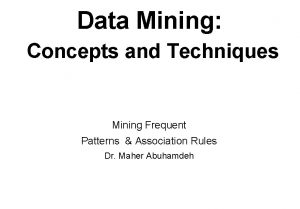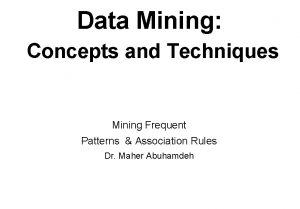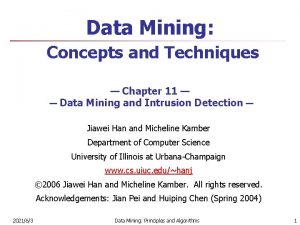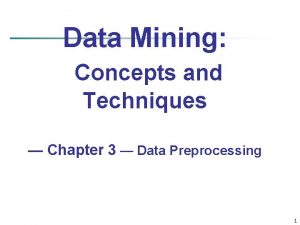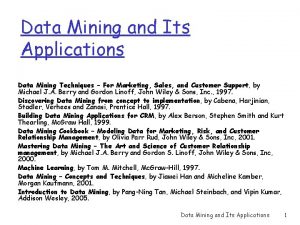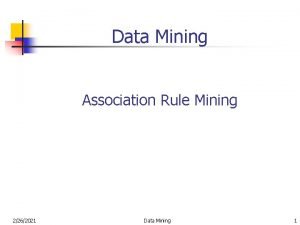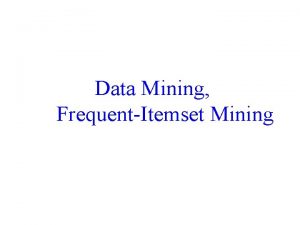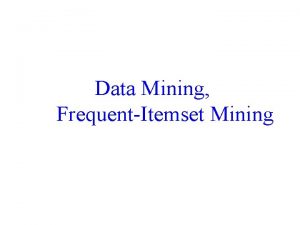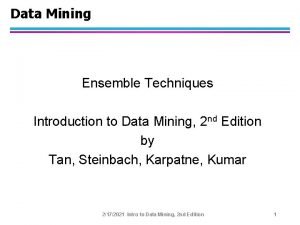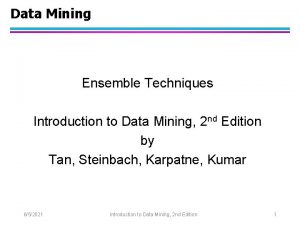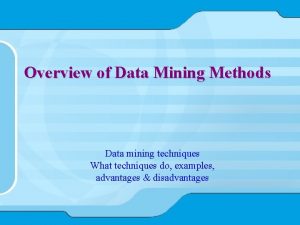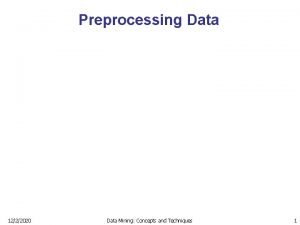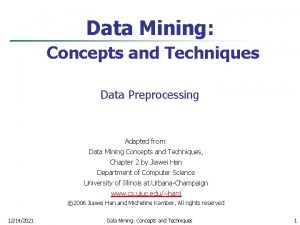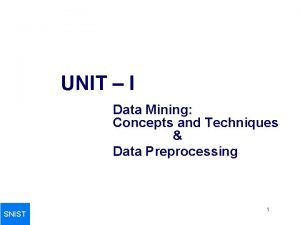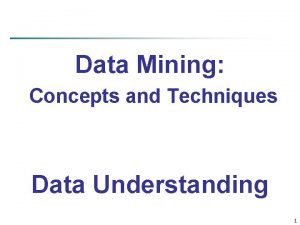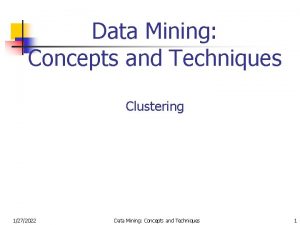Data Mining Concepts and Techniques 1 Chapter 1









































- Slides: 41

Data Mining: Concepts and Techniques 1

Chapter 1. Introduction n Why Data Mining? n What Is Data Mining? n A Multi-Dimensional View of Data Mining n What Kind of Data Can Be Mined? n What Kinds of Patterns Can Be Mined? n What Technology Are Used? n What Kind of Applications Are Targeted? n Major Issues in Data Mining n A Brief History of Data Mining and Data Mining Society n Summary 2

Why Data Mining? n The Explosive Growth of Data: from terabytes to petabytes n Data collection and data availability n Automated data collection tools, database systems, Web, computerized society n Major sources of abundant data n Business: Web, e-commerce, transactions, stocks, … n Science: Remote sensing, bioinformatics, scientific simulation, … n Society and everyone: news, digital cameras, You. Tube n We are drowning in data, but starving for knowledge! n “Necessity is the mother of invention”—Data mining—Automated analysis of massive data sets 3

Evolution of Sciences n Before 1600, empirical science n 1600 -1950 s, theoretical science n n 1950 s-1990 s, computational science n n n Over the last 50 years, most disciplines have grown a third, computational branch (e. g. empirical, theoretical, and computational ecology, or physics, or linguistics. ) Computational Science traditionally meant simulation. It grew out of our inability to find closed-form solutions for complex mathematical models. 1990 -now, data science n The flood of data from new scientific instruments and simulations n The ability to economically store and manage petabytes of data online n The Internet and computing Grid that makes all these archives universally accessible n n Each discipline has grown a theoretical component. Theoretical models often motivate experiments and generalize our understanding. Scientific info. management, acquisition, organization, query, and visualization tasks scale almost linearly with data volumes. Data mining is a major new challenge! Jim Gray and Alex Szalay, The World Wide Telescope: An Archetype for Online Science , Comm. ACM, 45(11): 50 -54, Nov. 2002 4

Evolution of Database Technology n 1960 s: n n 1970 s: n n n Relational data model, relational DBMS implementation 1980 s: n RDBMS, advanced data models (extended-relational, OO, deductive, etc. ) n Application-oriented DBMS (spatial, scientific, engineering, etc. ) 1990 s: n n Data collection, database creation, IMS and network DBMS Data mining, data warehousing, multimedia databases, and Web databases 2000 s n Stream data management and mining n Data mining and its applications n Web technology (XML, data integration) and global information systems 5

Chapter 1. Introduction n Why Data Mining? n What Is Data Mining? n A Multi-Dimensional View of Data Mining n What Kind of Data Can Be Mined? n What Kinds of Patterns Can Be Mined? n What Technology Are Used? n What Kind of Applications Are Targeted? n Major Issues in Data Mining n A Brief History of Data Mining and Data Mining Society n Summary 6

What Is Data Mining? n Data mining (knowledge discovery from data) n Extraction of interesting (non-trivial, implicit, previously unknown and potentially useful) patterns or knowledge from huge amount of data n n Alternative names n n Data mining: a misnomer? Knowledge discovery (mining) in databases (KDD), knowledge extraction, data/pattern analysis, data archeology, data dredging, information harvesting, business intelligence, etc. Watch out: Is everything “data mining”? n Simple search and query processing n (Deductive) expert systems 7

Knowledge Discovery (KDD) Process n n This is a view from typical database systems and data Pattern Evaluation warehousing communities Data mining plays an essential role in the knowledge discovery Data Mining process Task-relevant Data Warehouse Selection Data Cleaning Data Integration Databases 8

Example: A Web Mining Framework n Web mining usually involves n Data cleaning n Data integration from multiple sources n Warehousing the data n Data cube construction n Data selection for data mining n Data mining n Presentation of the mining results n Patterns and knowledge to be used or stored into knowledge-base 9

Data Mining in Business Intelligence Increasing potential to support business decisions Decision Making Data Presentation Visualization Techniques End User Business Analyst Data Mining Information Discovery Data Analyst Data Exploration Statistical Summary, Querying, and Reporting Data Preprocessing/Integration, Data Warehouses Data Sources Paper, Files, Web documents, Scientific experiments, Database Systems DBA 10

Example: Mining vs. Data Exploration n Business intelligence view n n n Warehouse, data cube, reporting but not much mining Business objects vs. data mining tools Supply chain example: tools Data presentation Exploration 11

KDD Process: A Typical View from ML and Statistics Input Data Pre. Processing Data integration Normalization Feature selection Dimension reduction n Data Mining Pattern discovery Association & correlation Classification Clustering Outlier analysis ………… Post. Processing Pattern evaluation selection interpretation visualization This is a view from typical machine learning and statistics communities 12

Example: Medical Data Mining n n Health care & medical data mining – often adopted such a view in statistics and machine learning Preprocessing of the data (including feature extraction and dimension reduction) n Classification or/and clustering processes n Post-processing for presentation 13

Chapter 1. Introduction n Why Data Mining? n What Is Data Mining? n A Multi-Dimensional View of Data Mining n What Kind of Data Can Be Mined? n What Kinds of Patterns Can Be Mined? n What Technology Are Used? n What Kind of Applications Are Targeted? n Major Issues in Data Mining n A Brief History of Data Mining and Data Mining Society n Summary 14

Multi-Dimensional View of Data Mining n n Data to be mined n Database data (extended-relational, object-oriented, heterogeneous, legacy), data warehouse, transactional data, stream, spatiotemporal, time-series, sequence, text and web, multi-media, graphs & social and information networks Knowledge to be mined (or: Data mining functions) n Characterization, discrimination, association, classification, clustering, trend/deviation, outlier analysis, etc. n Descriptive vs. predictive data mining n Multiple/integrated functions and mining at multiple levels Techniques utilized n Data-intensive, data warehouse (OLAP), machine learning, statistics, pattern recognition, visualization, high-performance, etc. Applications adapted n Retail, telecommunication, banking, fraud analysis, bio-data mining, stock market analysis, text mining, Web mining, etc. 15

Chapter 1. Introduction n Why Data Mining? n What Is Data Mining? n A Multi-Dimensional View of Data Mining n What Kind of Data Can Be Mined? n What Kinds of Patterns Can Be Mined? n What Technology Are Used? n What Kind of Applications Are Targeted? n Major Issues in Data Mining n A Brief History of Data Mining and Data Mining Society n Summary 16

Data Mining: On What Kinds of Data? n Database-oriented data sets and applications n n Relational database, data warehouse, transactional database Advanced data sets and advanced applications n Data streams and sensor data n Time-series data, temporal data, sequence data (incl. bio-sequences) n Structure data, graphs, social networks and multi-linked data n Object-relational databases n Heterogeneous databases and legacy databases n Spatial data and spatiotemporal data n Multimedia database n Text databases n The World-Wide Web 17

Chapter 1. Introduction n Why Data Mining? n What Is Data Mining? n A Multi-Dimensional View of Data Mining n What Kind of Data Can Be Mined? n What Kinds of Patterns Can Be Mined? n What Technology Are Used? n What Kind of Applications Are Targeted? n Major Issues in Data Mining n A Brief History of Data Mining and Data Mining Society n Summary 18

Data Mining Function: (1) Generalization n Information integration and data warehouse construction n n Data cube technology n n n Data cleaning, transformation, integration, and multidimensional data model Scalable methods for computing (i. e. , materializing) multidimensional aggregates OLAP (online analytical processing) Multidimensional concept description: Characterization and discrimination n Generalize, summarize, and contrast data characteristics, e. g. , dry vs. wet region 19

Data Mining Function: (2) Association and Correlation Analysis n Frequent patterns (or frequent itemsets) n n What items are frequently purchased together in your Walmart? Association, correlation vs. causality n A typical association rule n n Diaper Beer [0. 5%, 75%] (support, confidence) Are strongly associated items also strongly correlated? How to mine such patterns and rules efficiently in large datasets? How to use such patterns for classification, clustering, and other applications? 20

Data Mining Function: (3) Classification n Classification and label prediction n Construct models (functions) based on some training examples n Describe and distinguish classes or concepts for future prediction n Predict some unknown class labels Typical methods n n E. g. , classify countries based on (climate), or classify cars based on (gas mileage) Decision trees, naïve Bayesian classification, support vector machines, neural networks, rule-based classification, pattern-based classification, logistic regression, … Typical applications: n Credit card fraud detection, direct marketing, classifying stars, diseases, web-pages, … 21

Data Mining Function: (4) Cluster Analysis n n Unsupervised learning (i. e. , Class label is unknown) Group data to form new categories (i. e. , clusters), e. g. , cluster houses to find distribution patterns Principle: Maximizing intra-class similarity & minimizing interclass similarity Many methods and applications 22

Data Mining Function: (5) Outlier Analysis n Outlier analysis n n Outlier: A data object that does not comply with the general behavior of the data Noise or exception? ― One person’s garbage could be another person’s treasure n Methods: by product of clustering or regression analysis, … n Useful in fraud detection, rare events analysis 23

Time and Ordering: Sequential Pattern, Trend and Evolution Analysis n n Sequence, trend and evolution analysis n Trend, time-series, and deviation analysis: e. g. , regression and value prediction n Sequential pattern mining n e. g. , first buy digital camera, then buy large SD memory cards n Periodicity analysis n Motifs and biological sequence analysis n Approximate and consecutive motifs n Similarity-based analysis Mining data streams n Ordered, time-varying, potentially infinite, data streams 24

Structure and Network Analysis n n n Graph mining n Finding frequent subgraphs (e. g. , chemical compounds), trees (XML), substructures (web fragments) Information network analysis n Social networks: actors (objects, nodes) and relationships (edges) n e. g. , author networks in CS, terrorist networks n Multiple heterogeneous networks n A person could be multiple information networks: friends, family, classmates, … n Links carry a lot of semantic information: Link mining Web mining n Web is a big information network: from Page. Rank to Google n Analysis of Web information networks n Web community discovery, opinion mining, usage mining, … 25

Evaluation of Knowledge n n Are all mined knowledge interesting? n One can mine tremendous amount of “patterns” and knowledge n Some may fit only certain dimension space (time, location, …) n Some may not be representative, may be transient, … Evaluation of mined knowledge → directly mine only interesting knowledge? n Descriptive vs. predictive n Coverage n Typicality vs. novelty n Accuracy n Timeliness n … 26

Chapter 1. Introduction n Why Data Mining? n What Is Data Mining? n A Multi-Dimensional View of Data Mining n What Kind of Data Can Be Mined? n What Kinds of Patterns Can Be Mined? n What Technology Are Used? n What Kind of Applications Are Targeted? n Major Issues in Data Mining n A Brief History of Data Mining and Data Mining Society n Summary 27

Data Mining: Confluence of Multiple Disciplines Machine Learning Applications Algorithm Pattern Recognition Data Mining Database Technology Statistics Visualization High-Performance Computing 28

Why Confluence of Multiple Disciplines? n Tremendous amount of data n n High-dimensionality of data n n Micro-array may have tens of thousands of dimensions High complexity of data n n n n Algorithms must be highly scalable to handle such as tera-bytes of data Data streams and sensor data Time-series data, temporal data, sequence data Structure data, graphs, social networks and multi-linked data Heterogeneous databases and legacy databases Spatial, spatiotemporal, multimedia, text and Web data Software programs, scientific simulations New and sophisticated applications 29

Chapter 1. Introduction n Why Data Mining? n What Is Data Mining? n A Multi-Dimensional View of Data Mining n What Kind of Data Can Be Mined? n What Kinds of Patterns Can Be Mined? n What Technology Are Used? n What Kind of Applications Are Targeted? n Major Issues in Data Mining n A Brief History of Data Mining and Data Mining Society n Summary 30

Applications of Data Mining n Web page analysis: from web page classification, clustering to Page. Rank & HITS algorithms n Collaborative analysis & recommender systems n Basket data analysis to targeted marketing n n n Biological and medical data analysis: classification, cluster analysis (microarray data analysis), biological sequence analysis, biological network analysis Data mining and software engineering (e. g. , IEEE Computer, Aug. 2009 issue) From major dedicated data mining systems/tools (e. g. , SAS, MS SQLServer Analysis Manager, Oracle Data Mining Tools) to invisible data mining 31

Chapter 1. Introduction n Why Data Mining? n What Is Data Mining? n A Multi-Dimensional View of Data Mining n What Kind of Data Can Be Mined? n What Kinds of Patterns Can Be Mined? n What Technology Are Used? n What Kind of Applications Are Targeted? n Major Issues in Data Mining n A Brief History of Data Mining and Data Mining Society n Summary 32

Major Issues in Data Mining (1) n n Mining Methodology n Mining various and new kinds of knowledge n Mining knowledge in multi-dimensional space n Data mining: An interdisciplinary effort n Boosting the power of discovery in a networked environment n Handling noise, uncertainty, and incompleteness of data n Pattern evaluation and pattern- or constraint-guided mining User Interaction n Interactive mining n Incorporation of background knowledge n Presentation and visualization of data mining results 33

Major Issues in Data Mining (2) n n n Efficiency and Scalability n Efficiency and scalability of data mining algorithms n Parallel, distributed, stream, and incremental mining methods Diversity of data types n Handling complex types of data n Mining dynamic, networked, and global data repositories Data mining and society n Social impacts of data mining n Privacy-preserving data mining n Invisible data mining 34

Chapter 1. Introduction n Why Data Mining? n What Is Data Mining? n A Multi-Dimensional View of Data Mining n What Kind of Data Can Be Mined? n What Kinds of Patterns Can Be Mined? n What Technology Are Used? n What Kind of Applications Are Targeted? n Major Issues in Data Mining n A Brief History of Data Mining and Data Mining Society n Summary 35

A Brief History of Data Mining Society n 1989 IJCAI Workshop on Knowledge Discovery in Databases n n 1991 -1994 Workshops on Knowledge Discovery in Databases n n Knowledge Discovery in Databases (G. Piatetsky-Shapiro and W. Frawley, 1991) Advances in Knowledge Discovery and Data Mining (U. Fayyad, G. Piatetsky-Shapiro, P. Smyth, and R. Uthurusamy, 1996) 1995 -1998 International Conferences on Knowledge Discovery in Databases and Data Mining (KDD’ 95 -98) n Journal of Data Mining and Knowledge Discovery (1997) n ACM SIGKDD conferences since 1998 and SIGKDD Explorations n More conferences on data mining n n PAKDD (1997), PKDD (1997), SIAM-Data Mining (2001), (IEEE) ICDM (2001), etc. ACM Transactions on KDD starting in 2007 36

Conferences and Journals on Data Mining n KDD Conferences n ACM SIGKDD Int. Conf. on Knowledge Discovery in Databases and Data Mining (KDD) n SIAM Data Mining Conf. (SDM) n (IEEE) Int. Conf. on Data Mining (ICDM) n European Conf. on Machine Learning and Principles and practices of Knowledge Discovery and Data Mining (ECML-PKDD) n Pacific-Asia Conf. on Knowledge Discovery and Data Mining (PAKDD) n Int. Conf. on Web Search and Data Mining (WSDM) n Other related conferences n n n DB conferences: ACM SIGMOD, VLDB, ICDE, EDBT, ICDT, … Web and IR conferences: WWW, SIGIR, WSDM n ML conferences: ICML, NIPS n PR conferences: CVPR, Journals n n Data Mining and Knowledge Discovery (DAMI or DMKD) IEEE Trans. On Knowledge and Data Eng. (TKDE) n KDD Explorations n ACM Trans. on KDD 37

Where to Find References? DBLP, Cite. Seer, Google n Data mining and KDD (SIGKDD: CDROM) n n n Database systems (SIGMOD: ACM SIGMOD Anthology—CD ROM) n n n Conferences: SIGIR, WWW, CIKM, etc. Journals: WWW: Internet and Web Information Systems, Statistics n n n Conferences: Machine learning (ML), AAAI, IJCAI, COLT (Learning Theory), CVPR, NIPS, etc. Journals: Machine Learning, Artificial Intelligence, Knowledge and Information Systems, IEEE -PAMI, etc. Web and IR n n Conferences: ACM-SIGMOD, ACM-PODS, VLDB, IEEE-ICDE, EDBT, ICDT, DASFAA Journals: IEEE-TKDE, ACM-TODS/TOIS, JIIS, J. ACM, VLDB J. , Info. Sys. , etc. AI & Machine Learning n n Conferences: ACM-SIGKDD, IEEE-ICDM, SIAM-DM, PKDD, PAKDD, etc. Journal: Data Mining and Knowledge Discovery, KDD Explorations, ACM TKDD Conferences: Joint Stat. Meeting, etc. Journals: Annals of statistics, etc. Visualization n n Conference proceedings: CHI, ACM-SIGGraph, etc. Journals: IEEE Trans. visualization and computer graphics, etc. 38

Chapter 1. Introduction n Why Data Mining? n What Is Data Mining? n A Multi-Dimensional View of Data Mining n What Kind of Data Can Be Mined? n What Kinds of Patterns Can Be Mined? n What Technology Are Used? n What Kind of Applications Are Targeted? n Major Issues in Data Mining n A Brief History of Data Mining and Data Mining Society n Summary 39

Summary n n n Data mining: Discovering interesting patterns and knowledge from massive amount of data A natural evolution of database technology, in great demand, with wide applications A KDD process includes data cleaning, data integration, data selection, transformation, data mining, pattern evaluation, and knowledge presentation Mining can be performed in a variety of data Data mining functionalities: characterization, discrimination, association, classification, clustering, outlier and trend analysis, etc. n Data mining technologies and applications n Major issues in data mining 40

Recommended Reference Books n S. Chakrabarti. Mining the Web: Statistical Analysis of Hypertex and Semi-Structured Data. Morgan Kaufmann, 2002 n R. O. Duda, P. E. Hart, and D. G. Stork, Pattern Classification, 2 ed. , Wiley-Interscience, 2000 n T. Dasu and T. Johnson. Exploratory Data Mining and Data Cleaning. John Wiley & Sons, 2003 n U. M. Fayyad, G. Piatetsky-Shapiro, P. Smyth, and R. Uthurusamy. Advances in Knowledge Discovery and Data Mining. AAAI/MIT Press, 1996 n U. Fayyad, G. Grinstein, and A. Wierse, Information Visualization in Data Mining and Knowledge Discovery, Morgan Kaufmann, 2001 n J. Han and M. Kamber. Data Mining: Concepts and Techniques. Morgan Kaufmann, 3 rd ed. , 2011 n D. J. Hand, H. Mannila, and P. Smyth, Principles of Data Mining, MIT Press, 2001 n T. Hastie, R. Tibshirani, and J. Friedman, The Elements of Statistical Learning: Data Mining, Inference, and Prediction, 2 nd ed. , Springer-Verlag, 2009 n B. Liu, Web Data Mining, Springer 2006. n T. M. Mitchell, Machine Learning, Mc. Graw Hill, 1997 n G. Piatetsky-Shapiro and W. J. Frawley. Knowledge Discovery in Databases. AAAI/MIT Press, 1991 n P. -N. Tan, M. Steinbach and V. Kumar, Introduction to Data Mining, Wiley, 2005 n S. M. Weiss and N. Indurkhya, Predictive Data Mining, Morgan Kaufmann, 1998 n I. H. Witten and E. Frank, Data Mining: Practical Machine Learning Tools and Techniques with Java Implementations, Morgan Kaufmann, 2 nd ed. 2005 41
 Data mining confluence of multiple disciplines
Data mining confluence of multiple disciplines Function of data mining
Function of data mining Data mining slides
Data mining slides Data mining concepts and techniques slides
Data mining concepts and techniques slides Mining complex types of data in data mining
Mining complex types of data in data mining Mining multimedia databases in data mining
Mining multimedia databases in data mining Basic concepts in mining data streams
Basic concepts in mining data streams Basic concepts of classification in data mining
Basic concepts of classification in data mining 2170715
2170715 Association data mining techniques
Association data mining techniques Classification alternative techniques in data mining
Classification alternative techniques in data mining Difference between strip mining and open pit mining
Difference between strip mining and open pit mining Web text mining
Web text mining What is kdd process in data mining
What is kdd process in data mining Analitical cubism
Analitical cubism Olap data mining
Olap data mining Introduction to data warehousing and data mining
Introduction to data warehousing and data mining Strip mining vs open pit mining
Strip mining vs open pit mining Chapter 13 mineral resources and mining worksheet answers
Chapter 13 mineral resources and mining worksheet answers Data reduction in data mining
Data reduction in data mining What is missing data in data mining
What is missing data in data mining Data reduction in data mining
Data reduction in data mining Data reduction in data mining
Data reduction in data mining Data reduction in data mining
Data reduction in data mining Data cube technology in data mining
Data cube technology in data mining Data reduction in data mining
Data reduction in data mining Data warehouse dan data mining
Data warehouse dan data mining Perbedaan data warehouse dan data mining
Perbedaan data warehouse dan data mining Mining complex types of data
Mining complex types of data Noisy data in data mining
Noisy data in data mining Independent data mart architecture
Independent data mart architecture Markku roiha
Markku roiha Data compression in data mining
Data compression in data mining Data warehouse dan data mining
Data warehouse dan data mining Cs 412 introduction to data mining
Cs 412 introduction to data mining Concepts techniques and models of computer programming
Concepts techniques and models of computer programming Dfd chapter 5
Dfd chapter 5 Typical process description tools include
Typical process description tools include Overfitting in data mining
Overfitting in data mining Overfitting and underfitting in data mining
Overfitting and underfitting in data mining Characterization and comparison in data mining
Characterization and comparison in data mining List the primitives that specify a data mining task.
List the primitives that specify a data mining task.
